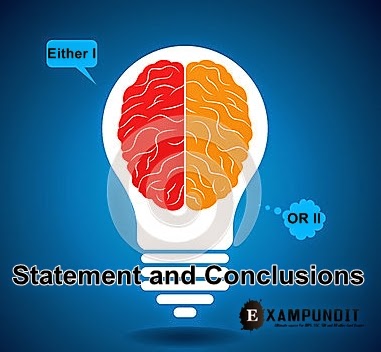Directions (1-10): In each of the questions below are given four statements followed by four conclusions numbered I, II, III and IV. You have to take the given statements to be true even if they seem to be at variance from commonly known facts. Read all the conclusions and then decide which of the given conclusions logically, follow s from the given statements disregarding commonly known facts.
1. Statements:
All drums are tubes.
Some tubes are pipes.
No pipe is stick.
Some sticks are rubbers.
Conclusions:
I. Some robbers are tubes.
II. Some sticks are drums.
III. Some pipes are drums.
IV. Some sticks are tubes.
a) None follows
b) Only I follow
c) Only I and II follow
d) Only I and III follow
e) Only III follows
2. Statements:
Some pens are rooms.
All rooms are walls.
Some walls are bricks.
All bricks are slates.
Conclusions:
I. Some slates are walls.
II. Some walls are pens.
III. Some bricks are rooms.
IV. Some slates are rooms.
a) Only I and III follow
b) Only II and III follow
c) Only I and II follow
d) Only II and IV follow
e) None of these
3. Statements:
Some chairs are pencils.
Some pencils are bottles.
Some bottles are bags.
Some bags are books.
Conclusions:
I. Some books are pencils.
II. Some books are chairs.
III. No book is pencil.
IV. Some bags are chairs.
a) Only I follows
b) Only either I or III follows
c) Only III follows
d) Only IV follows
e) None of these
4. Statements:
Some roads are buses.
All buses are trains.
Some trains are trucks.
All trucks are kites.
Conclusions:
a) None follows
b) Only I follow
c) Only II follow
d) Only III follow
e) None of these
5. Statements:
All beads are rings.
All rings are bangles.
All bangles are tyres.
All tyres are pendants.
Conclusions:
I. Some pendants are beads.
II. Some tyres are rings.
III. Some bangles are beads.
IV. Some pendants are rings.
a) Only I and II follow
b) Only I, II and III follow
c) Only II, III and IV follow
d) Only I, III and IV follow
e) All follows
6. Statements:
Some desks are fruits.
All fruits are flowers.
Some flowers are desks.
Some branches are roots.
Conclusions:
I. Some roots are flowers.
II. No desk is branch.
III. Some flowers are desks.
IV. Some branches are desks.
a) Only either II or IV follow
b) Only III follows
c) Only either II or IV follow
d) Only III and IV follow
e) None of these
7. Statements:
All booklets are packets.
All packets are bottles.
Some bottles are cans.
Some cans are pitchers.
Conclusions:
I. Some pitchers are bottles.
II. Some cans are packets.
III. Some bottles are booklets.
a) None follows
b) Only I follows
c) Only II follows
d) Only III follow
e) Only II and III follow
8. Statements:
Some ropes are walls.
Some walls are sticks.
All sticks are Chairs.
All chairs are tables.
Conclusions:
I. Some tables are walls.
II. Some chairs are ropes.
III. Some sticks are ropes.
a) None follows
b) Only I follows
c) Only II follows
d) Only III follows
e) Only II and III follow
9. Statements:
Some rivers are jungles.
Some jungles are horses.
Some horses are tents.
Some tents are buildings.
Conclusions:
I. Some buildings are horses.
II. Some tents are jungles.
III. Some horses are rivers.
a) None follows
b) Only I follows
c) Only II follows
d) Only III follows
e) Only I and III follows
10. Statements:
Some pens are knives.
All knives are pins.
Some pins are needles.
All needles are chains.
Conclusions:
I. Some chains are pins.
II. Some needles are knives
III. Some pins are pens.
a) Only l follows
b) Only II follows
c) Only III follows
d) Only II and III follows
e) None of-these
Answers:
1. A
2. C
3. B
4. A
5. E
6. C
7. D
8. B
9. A
10. E



